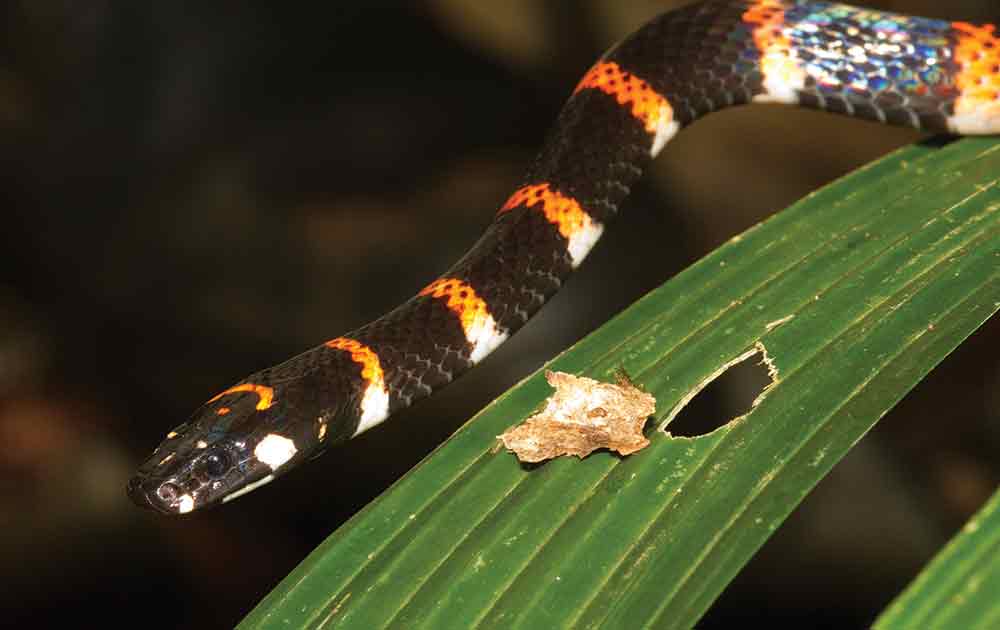The mimic imitates the more dangerous species to deter predators.
Batesian mimicry occurs when a harmless species imitates the aposematic (traits or coloration that serve as a warning to predators, making the mimic not worth eating or attacking) signals of a more dangerous species. The harmless species is called the mimic, and the species it is mimicking is called the model. The mimic imitates the more dangerous species to deter predators. Curiously, in herpetology, snakes are not only imitated by other snakes.
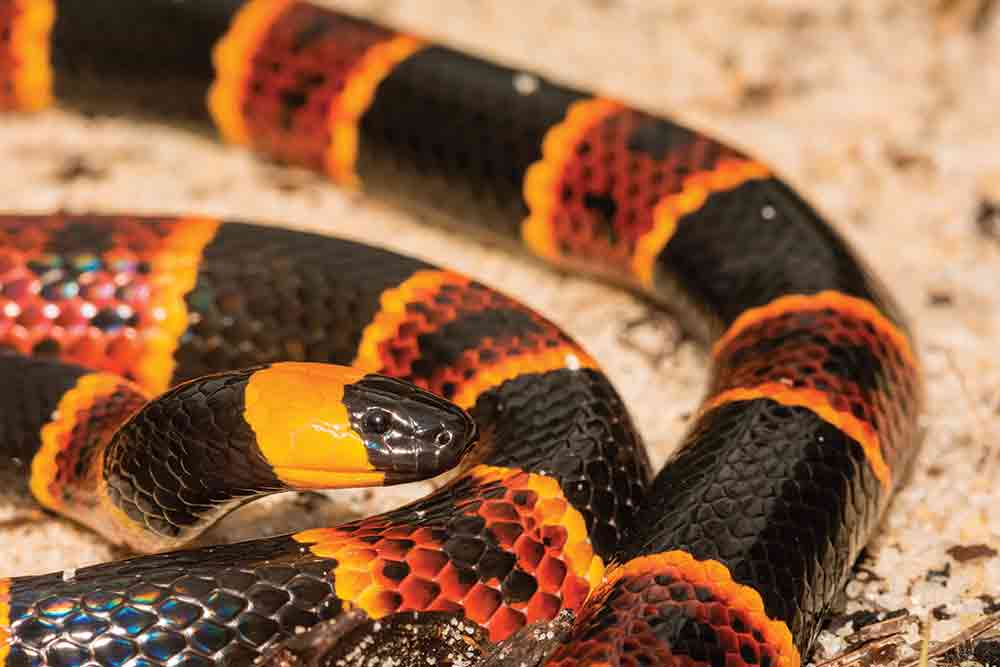
Eastern coral snake. Photo by Jay Ondreicka/Shutterstock
The Gaboon viper (Bitis gabonica) a venomous snake is imitated by the Congolese giant toad (Sclerophrys channingi). The toad replicates the viper’s head uncannily by possessing the same tan color, two dark brown dots, and a brown straight line that runs down its back. (1) The toad also has pronounced brow lines above its eyes that resembles those of a snake’s. It also has brown coloration on both sides of its body that makes it appear like a gaping viper from the side whenever it is startled or disturbed. The toad also imitates B. gabonica’s hissing, which is a deep and steady rhythm similar to air being released from a balloon. (2)
Caterpillars and Pit Vipers
Two rather cute snake impersonators are caterpillars! The pupa of the Trinidadian Dynastor darius darius butterfly hangs on a leaf and appears to look like the head of a snake with two big adorable cartoony eyes. This cuteness though is limited to the human eye. During the last part of its pupal stage, the larvae of D. darius darius becomes immobile. Having spent its larval life munching on leaves, D. darius darius is a great protein source for birds and other predators. And nature bestowed it with the ability to transform its chrysalis into a mimic head of no other than the Gaboon viper (Bitis gabonica) with scales and eyes, thus becoming a discouraging sight to those thinking of preying on it. It is a rather peculiar case of mimicry, as B. gabonica is not found in Trinidad but in the rainforest of Gabon in Africa. When disturbed, the pupa also has the ability to “wave violently back and forth” making it appear like a snake ready to strike. (3) (4)
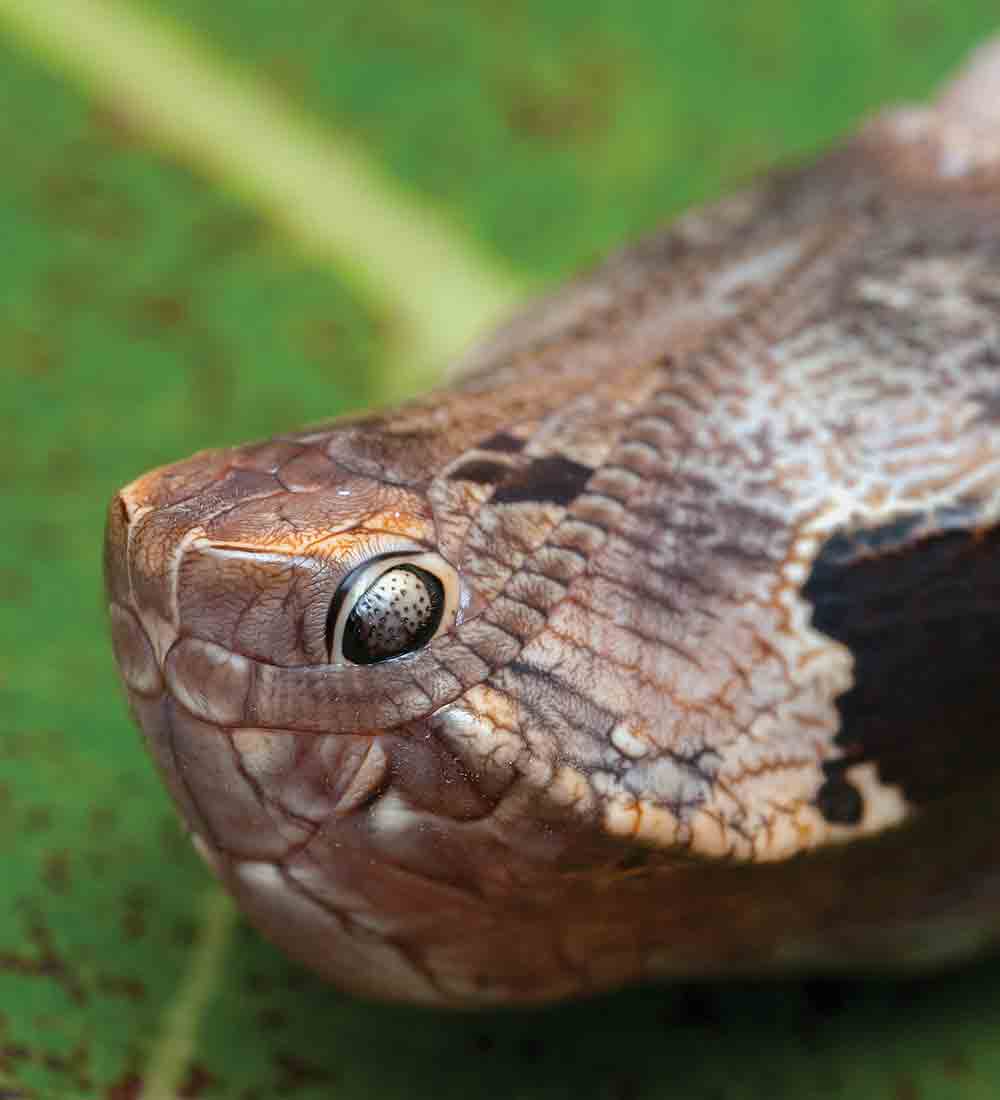
The Gaboon viper butterfly pupae mimic, Dynastor darius Photo by fntproject/Shutterstock
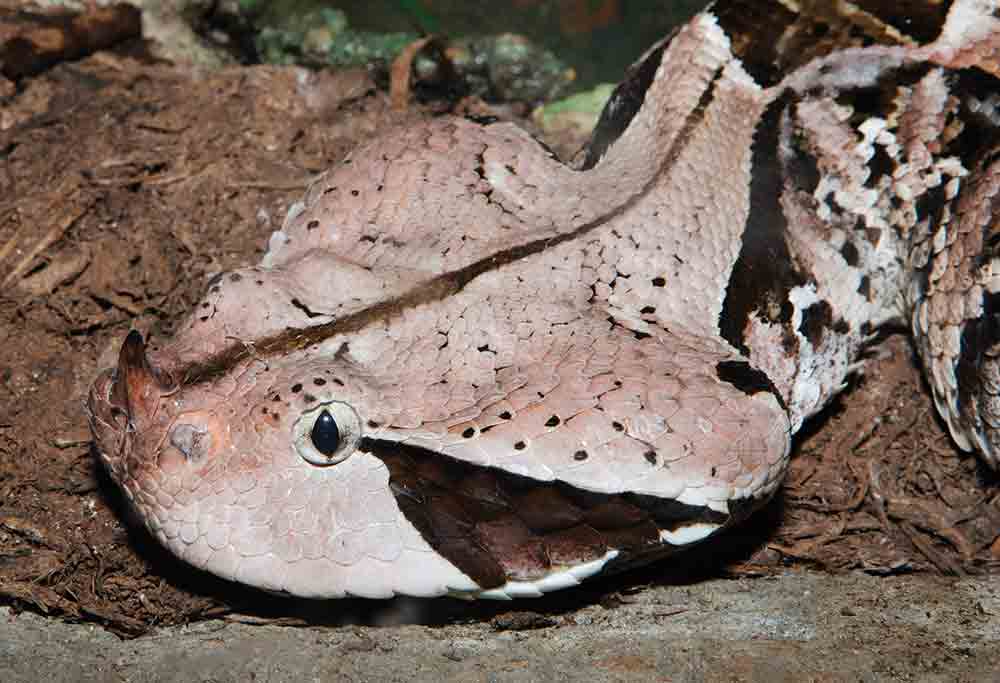
The head of the Gaboon viper. Photo by shutterstock/Michael Lynch
Another snake impersonator among the caterpillars is the hawk moth caterpillar (Hemeroplanes triptolemus) which is native to South America. Filmmaker Filipe DeAndre was able to film what seemed to be a harmless looking caterpillar’s total transformation into a somewhat short-bodied venomous-looking snake. In the clip, the caterpillar was initially seen to be munching on a leaf. Noticing the intruder it drops its front body, leaving only its hind legs to hold on to a branch. Once dangled, it expands its upper body and transforms into a miniature “viper” complete with diamond shaped head, false shiny eyes, heat pits, and snake scales. It then proceeds to jab at the air as if to strike at its adversary. This animal is indeed a fantastic impostor! (5)
Snake Mimicry
Batesian mimicry has become a common occurrence among non-venomous impostors and their venomous counterparts, with the coral snake probably being the most imitated of all by at least 150 snake species, including the scarlet kingsnake and the Sonoran Mountain kingsnake.
The Coral Snake
Coral snakes belong to the family Elapidae. which includes cobras and other are highly venomous snakes. However, they are reclusive and generally only bite when provoked. Of all the snake bite cases in the United States each year, approximately 2 percent are attributed to coral snakes. (6) Their diet includes smaller snakes, small skinks, and are occasionally cannibalistic. Most coral snakes are categorized as least concern (LC) by the International Union for Conservation of Nature (IUCN). There are not many known threats to coral snakes except that of habitat loss. The Catamayo coral snake (Micrurus catamayensis), endemic to Ecuador and the Merida coral snake (M. Meridensis) of Western Venezuela are listed as endangered species (EN). The Roatan coral snake (M.ruatanus) of Roatan Island and M. Medemi from Colombia are categorized as critically endangered (CR).
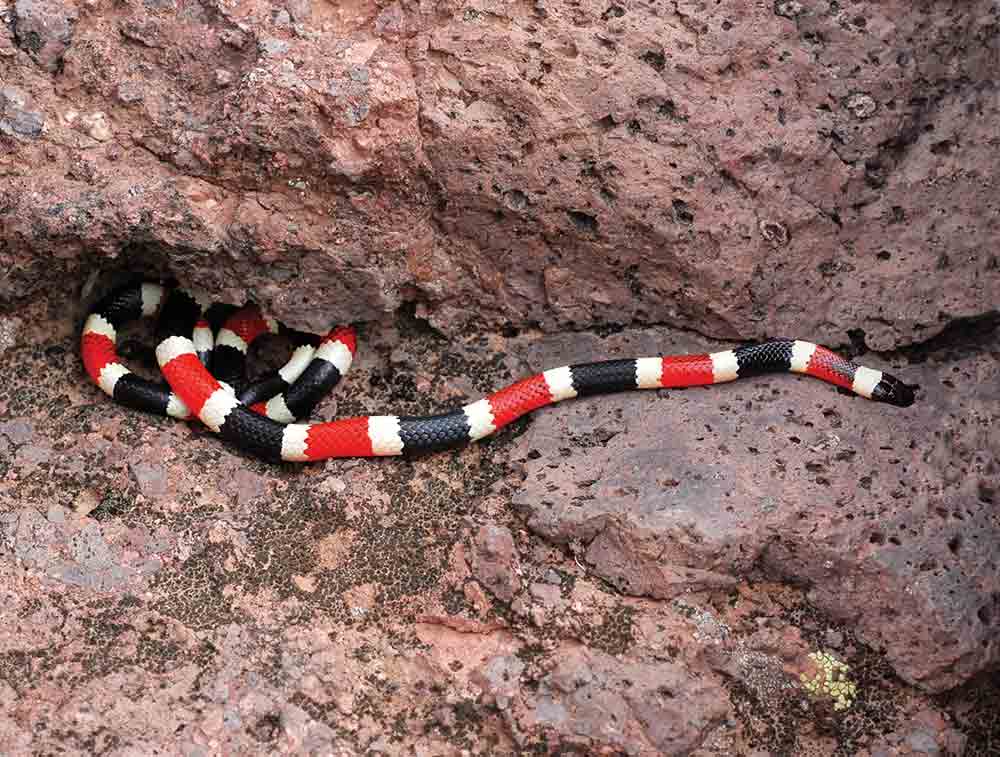
The Western coral snake is mimicked by the scarlet kingsnake. Photo by jokerbethyname/Shutterstock
Coral snakes are subdivided into two distinct groups: Old World and New World. The Old World snakes include 16 species and three genera (Calliophis, Hemibungarus, and Sinomicrucus). All three genera are found in Asia. The New World snakes are divided into two genera – Micruroides and Micrurus. The genus Micruroides contains only the species Micruroides euryxanthus also known as Sonoran coral snake or the Arizona coral snake. Micrurus on the other hand has at least 80 species. (7) This includes the Eastern coral snake (Micrucus fulvius) which is found in Florida and the Southeastern United States, and Texas coral snake (Micrurus tener) which is found in Texas and Northwestern Mexico.
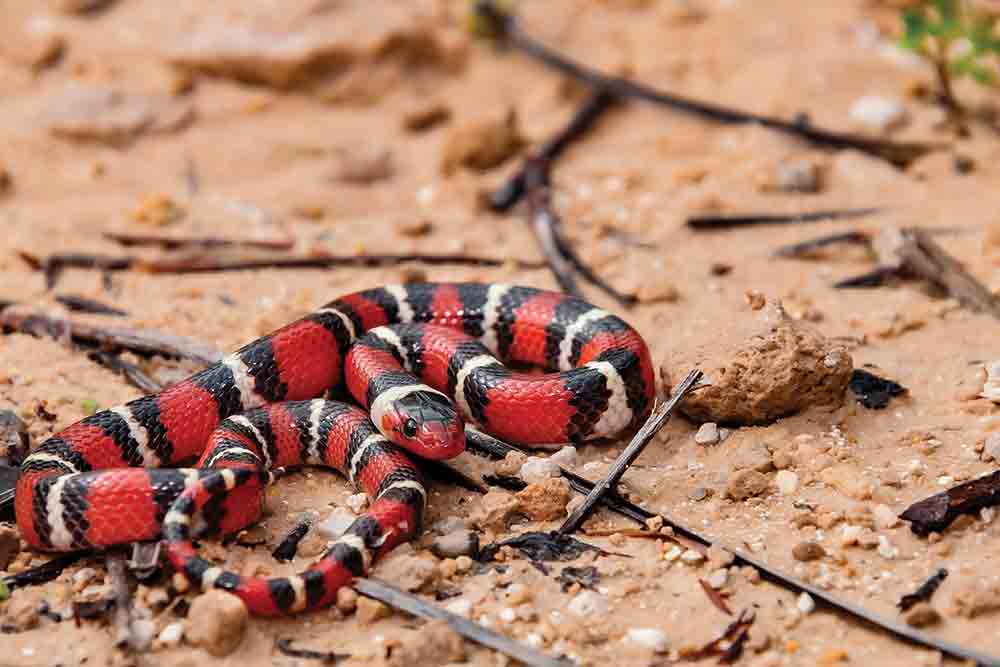
The scarlet kingsnake is a coral snake mimic.
We will focus on the New World coral snakes and their mimics.
Coral snakes use their distinctive bright color patterns so that birds will easily identify its bright ring pattern in contrast with the background and stay away from it. This pattern is described as aposematic signaling.
Red Touch Yellow, Kill a Fellow
“Red on yellow kill a fellow. Red on black friend of Jack,” goes the mnemonic used to identify the Eastern coral snake (Micrurus fluvius) from its mimics. This mnemonic is generally consistent with the M. fluvius in the United States and some species such as Oaxacan coral snake (M. Ephippifer) found in Mexico and Clark’s coral snake (M. clarki) found in Costa Rica and Panama.
The scarlet kingsnake (Lampropeltis elapsoides) possesses the three distinct black, red, and yellow color bands of the M. fluvius. However, the color arrangement and distribution of the bands vary. Generally, M. fluvius has a black head while its mimics have red tips on their heads. M. fluvius’ black head has a yellow band in the middle followed by a thick black band, a thin yellow band, a thick red band, a thin yellow band, a thick black band and so on until it reaches the tail where the red band disappears and only the black/yellow bands are present.
The scarlet kingsnake has a red tipped black head. The red tip is followed by a black band with a yellow band in the middle. The scarlet kingsnake looks like it is not one but multiple Japanese obi pillows wrapped around with a yellow obi belt. The yellow on black band is followed by a thick red band, yellow on black band, the pattern continuing toward the end of the tail. This is mostly the case between the M. fluvius and L. elapsoides. Although color band distribution aren’t the same and may vary, the similar striking colors keeps the L. elapsoides from its would be predators.
This protection provided by the mimicry of the M. fluvius by L. elapsoides is only limited to certain areas where both species are present, particularly Florida and the Southeastern United States.
A study conducted by scientists to find out if the resemblance of the two species is indeed Batesian mimicry proved to be true. The scientists created plasticine models of each of the snake species and set them up in the wild in two separate locations. A pair was placed in the south where M. fluvius can be found and the second pair was placed up north where M. fluvius is not known to exist. Plasticines are composed of wax and clay so that the scientists are able to determine the number of bird attacks. The results of the study conducted showed that the plasticines in the area where M. fluvius is not present acquired 50 percent bird attacks while the molds placed in the Southeastern area only received 6 percent bird attack. (8)
An illustration by John Megahan of an almost perfect mimicry of two different species of snakes is a classic example of a mimic co-existing with its model. Megahan’s illustration was drawn from preserved specimens of the harmless mimic Pliocercus elapoides and venomous coral snake (Micrurus nigrocinctus) caught in the same field site in the 1940s during a University of Michigan Museum Zoology expedition to Guatemala. The illustration showed that both snakes have the colors red, white and black present. Both heads are black with a white band. To the regular eye and even to the predator, to distinguish the mimic from the model in this case would be difficult.
Alison Davis Rabosky, an ecologist and evolutionary biologist at the University of Michigan, in describing Megahan’s illustration, said that although the pictures seem to show a mirror image of a single snake, they actually have different colored tails and scale patterns on the head, and different ratios of red to black. She also added that P. elapoides and M. nigrocinctus are separated by 65 million years of evolution. (9) (10) (11)
There are 150 known coral snake mimics around the world, all of which have the red and black banding similar to the venomous coral snake. The new world coral snake is the result of a 40 million-year evolution. And during this period, their mimics have already evolved 19 times. The distinct banding of the mimics only appeared when they coexisted with the coral snake.
Over time, the mimics have evolved independently from their venomous models and have continued changing their color pattern. This type of evolution is called phenotypic convergence.
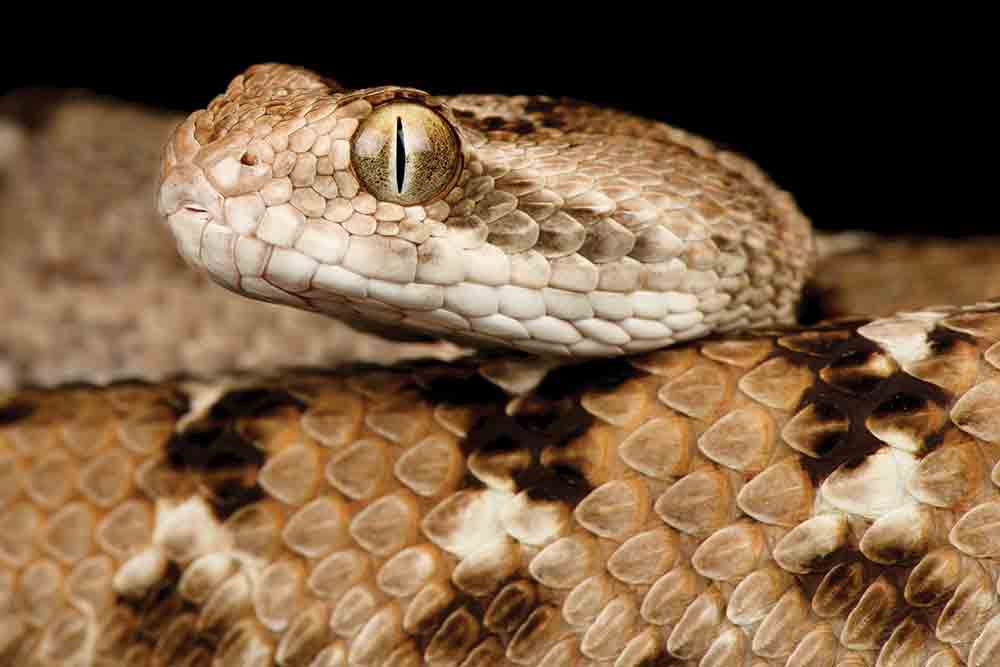
Dasypeltis scabra also mimics the Indian saw scaled viper (Echis carinatus) shown here. Photo by Reptiles4all/Shutterstock
Although the mimicry theory suggests that the mimic who has acquired the protective color pattern of the model species retains it nearly indefinitely, it doesn’t hold the same for snakes as evidenced in recent studies. Rabosky’s research revealed that the coloration pattern of coral snake mimics through phenotypic convergence are rapidly changing, encouraging a new view that mimicry is dynamic and constantly in flux. Rabosky’s team of researchers also found that the number of mimics in a particular given area outnumbered the deadly species two to six times more, another discovery that violates the theory that the venomous species should outnumber the innocuous species.
Daniel Rabosky, co-author of the same research mentions that the coral snake mimic remains. He also mentioned that the issue is not whether or not coral snake mimicry exists, but rather what factors are responsible for the very fast and unexpected dynamics of snake coloration over time. (10) (12)
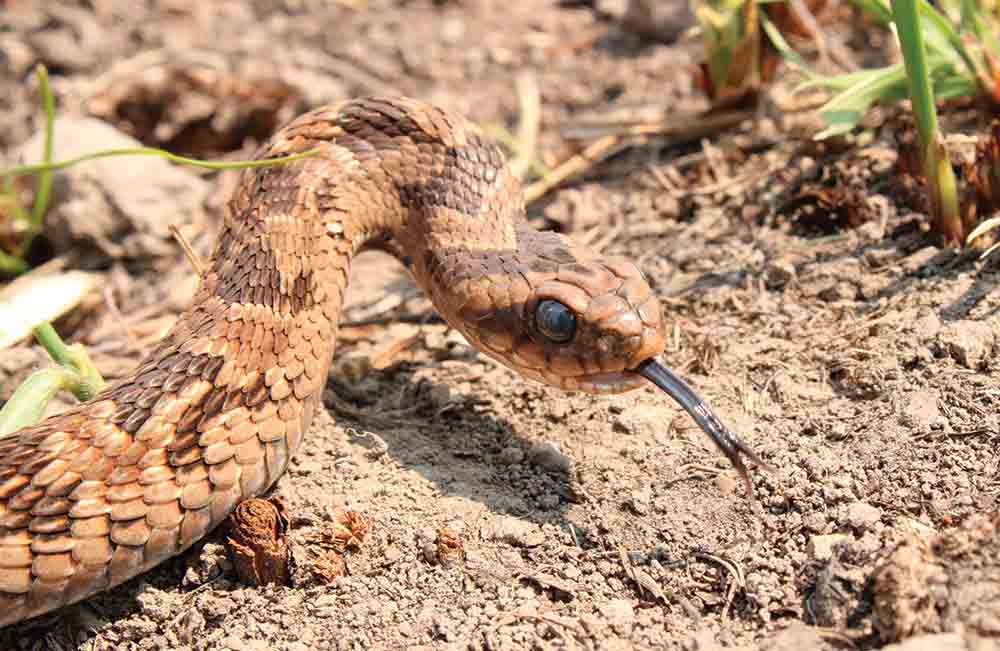
Causus rhombeatus, the rhombic night adder. Photo by Cormac Price/Shutterstock
Snakes and Robots
Alison Davis Rabosky also found while doing field work in the Peruvian Amazon that the snakes that they studied there not only look the same but can also act the same. Coral snakes can also have a warning display with curled tails and thrashing bodies, a statement she supported with a video showing a coral snake and a mimic showing strikingly similar body movements. During a seminar Rabosky was asked the following questions: 1. how unique is this display; 2. do all snake species do the same thing; and most critically 3. How important is the movement versus the coloration in deterring a predator. A. Rabosky said the only way to decouple motion from color would be through the use of snake robots which she initially thought to be impossible. (11)
However, Talia Moore, an assistant professor at the University of Michigan Department of Mechanical Engineering who specializes in utilizing engineering tools to study animal movement, said it is totally possible. While at the department of mechanical engineering, Moore has also been actively involved with the university’s Department of Ecology and Evolutionary Biology. Moore for a time was working with soft robots. Moore said that soft robots run on air instead of electricity. The shapes are pre-programmed during construction by wrapping fiber around rubber tubes so that same can be tied up and smashed without causing any damage to the person or the robot. According to Moore, it’s difficult to study how snake movement or any other animal movement translates into animal survival such as having to go to the wild and get very lucky to see animals before they get devoured or to conduct experiments in labs, which is difficult in the case of snakes and their predators.

The spicebush swallowtail caterpillar mimics snakes.
So Moore concluded that robotic snakes can replace real snakes to safely study how the hawks respond to different snake behaviors. Moore in an MCube talk explains the whole process as follows: The team generated a thousand videos of 161 individual snakes representing 51 species. The videos were of different responses of snakes to simulated predators. Each video is analyzed to create a database of snake behaviors, logging the snake responses to the simulated predators. The snakes during the behaviors are then tracked in 3D in order to mathematically follow each part of the snake body in both space and time and use the data to design the snake robot. The rubber snake moves and changes shape by fiber angle and air pressure. The snake robots can then be programmed and painted to move and look like any snake species. The robotic snakes will then be presented to the hawks to understand how snakes use combinations of color and movement to communicate to their predators. (11)
According to Rabosky, the end goal of their project is to introduce the robots back to the predators producing not only biologically inspired robots but taking those robots back to biology and test how different color and behavior combinations can protect the snake from death. She added that people may think predation is not a big deal. “But getting eaten is a real and constant threat in nature and which animals die and which do not is one of the main drivers shaping the world around you,” Rabosky said. (11)
Works Cited
1. Andrew, Scottie. A clever African toad learned to copy a deadly snake to trick predators out of eating it. cnn.com. [Online] October 21, 2019. .
2. A remarkable example of suspected Batesian mimicry of Gaboon Vipers (Reptilia: Viperidae: Bitis gabonica) by Congolese Giant Toads (Amphibia: Bufonidae: Sclerophrys channingi). Eugene R. Vaughan, Mark S. Teshera, Chifundera Kusamba, Theresa R. Edmonston & Eli Greenbaum. 1853-1871, s.l. : Journal of Natural History, 2019, Vols. 53:29-30. DOI: 10.1080/00222933.2019.1669730.
3. Dickinson, Ian. Meet the Snake Mimic that will make You Question Everything. earthtouchnews.com. [Online] May 19, 2015.
4. Life History of Dynastor Darius . Aiello, Anette and Silbergleid, Robert. 04, s.l. : PSYCHE, 1979, Vol. 85.
5. DeAndrade, Felipe. The Caterpillar That Looks Like a Snake | Untamed. Nat Geo WILD.
6. Coral Snake Bite Treatment. poison.org. [Online].
7. Hotle, Doug. Coral Snakes of the United States. Reptiles Magazine. [Online] July 22, 2015.
8. Ross, Michelle. Moment of Science : Batesian Mimicry in Snakes. Indiana Public Media. [Online] Augusr 6 2018..
9. Megahan, John. Biomimicry | Nature Illustrated | Art and Illustration of Nature . johnmegahan.com, s.l. : January 4, 2018.
10. Jim Erickson, University of Michigan. Deadly Snakes or Just Pretending? The Evolution of Mimicry. PHYS.ORG. [Online] May 6, 2016.
11. MCube. What Robots Can Teach Us About Snakes: Communicating with Color and Motion. YouTube. [Online] MCubed, December 5 2017. www.youtube.com.
12. Coral Snakes Predict the Evolution of Mimicry across New World Snakes. Davis Rabosky, A., Cox, C., Rabosky, D. ,et al. s.l. : Nat Commun, 5 May 2016, Vol. 7. 11484.
13. Wallace, Alfred Russell. Mimicry and Other Protective Resemblances Among Animals. The Alfred Russell Page. [Online] 1 July 1867.

